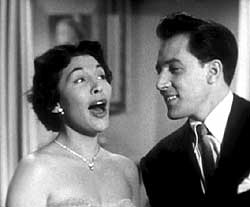 Toni Arden at piano looking like someone's mom dressed for a cocktail party is concentrating & practicing a piece, too badly to tell what it is.
Toni Arden at piano looking like someone's mom dressed for a cocktail party is concentrating & practicing a piece, too badly to tell what it is.
From another room Jan Arden strolls in thumbing through a magazine, dressed like Ricky at the Copa Cabana. It looks like just an average day at home with Mr. & Mrs. Like To Overdress, but they're not married -- we hope -- as we're being introduced to a brother & sister act.
With names like "Toni & Jan" (with Toni's name frequently mispelled Tony), one is bound to think the woman at the piano is Jan, so this telescription makes a production of her saying to her brother, "Jan, would you sing a song with me please?" by which we know she's Toni.
And since the song is Do I Love You (1951) then hell yes Jan wants to sing that to his sister.
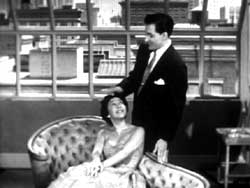 She stands from the piano & the magic orchestra hidden somewhere in their home begins to play. It comes off as an awful song perhaps only because they're awful singer, Toni a mite worse than Jan. She stands from the piano & the magic orchestra hidden somewhere in their home begins to play. It comes off as an awful song perhaps only because they're awful singer, Toni a mite worse than Jan.
Toni was one of Vic Damone's favorite singers, & condemnation doesn't come any greater than that.
Yet it seems I once upon a time was afflicted with great fondness for her voice since as a child I loved her on a recording of the huge child-appeal novelty number "Marzie Dotes."
Either together or separately Toni & Jan were responsible for over a dozen telescriptions. This is the first one I've listened to & if it's representative I wouldn't care whether or not I stumbled on the others. But I gotta admit, it's interesting, in a sick sick way, when Toni does such loving eye-contact with her brother on these "be mine" lyrics.
They even dance together very romantically. I mean, it's great there's no sibling rivalry or anything like that, but I hope they adopt, as we don't need any two-headed babies.
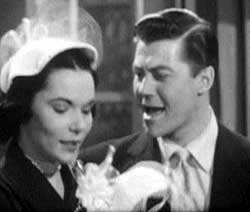 Gene Williams was the vocalist for the Claude Thornhill Orchestra in the 1940s, then in the '50s had his own shortlived orchestra. He appears as a single act on the telescription From This Moment On (1951).
Gene Williams was the vocalist for the Claude Thornhill Orchestra in the 1940s, then in the '50s had his own shortlived orchestra. He appears as a single act on the telescription From This Moment On (1951).
A woman enters through a door carrying several boxes, apparently wedding gifts. It's a hotel room; this is apparently the beginning of a honeymoon.
Her husband follows her into the room, sets down luggage, locks the door. As his fresh young bride puts down the packages, he joins her at her side & begins singing to her insinuatingly though she seems more interested in finding out what's in the wedding boxes.
"From this moment on, you for me dear/ Only two for tea dear, from this moment on/ From this happy day, no more blue song/ Only hoop-do-do song..." All the while she has a sour face & he's trying to get her attention away from the gifts.
With lyrics like "You've got the love I need so much" answered by her indifference, this guy maybe better face it, he just tied the knot with a frigid woman. She doesn't even take off her gloves & hat she's so shut off from the guy, but maybe it's only because he's such a crappy crooner.
But then unexpectedly the music goes a little bit burlesque with a horn & she gets a certain look in her eyes as she removes a glove striptease style with the focus on tease with no strip, with still blessed little promise of action.
She hands him one of her gloves & without even looking at it he throws it on the floor, so clearly he's pissed even though he keeps smiling & wheedling through song.
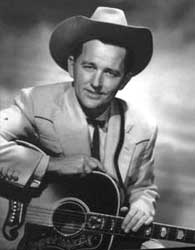 I try to imagine the contemporary audience that would put a coin in a panoram jukebox to watch & listen to certain types of music. It's usually pretty easy to envision who might be listening to what. I try to imagine the contemporary audience that would put a coin in a panoram jukebox to watch & listen to certain types of music. It's usually pretty easy to envision who might be listening to what.
But now & then there's something or another I find it difficult to imagine any "volunteer" customer would pay a nickle or a dime specifically to hear it.
Of course, the soundies came seven on a loop, & you couldn't really make a personal selection but might have to pay for multiple soundies to reach the one you actually wanted. This may well have encouraged the soundie filmmakers to include a mite too much cheaply gotten acts.
It's hard to imagine who'd pay a dime to hear the Arthur Johnston Singers even if they had doing something better than The Singing Hills (1941). After filming them, producers must've taken a long look at what they'd done, & never filmed this group again.
The singing group is slightly better than that excreble soundies choras called the Men & Maids of Melody. They are attempting to overcome their own banality by faking western swing, without ever taking on quite that much character.
The guys are shown dressed as cowboys seated around a barn. The women though heard on the soundtrack are unseen, except for a moment when three gals appear as ghostly spirits over the hills chorasing "oo-oo, oo-oo."
One guy is sitting oiling his rifle as it sticks straight out from his crotch. At one point another guy who had been holding a lasoo makes a pathetic effort to twirl it, utterly failing.
A jump cut from a tenor solo moment takes us to a woman seated by herself in a dark room, her face brightly lit by a kerosene lamp, not singing; there'll be a second moment like this, just decorating the soundie with prettier faces than those guys.
There are also a couple of jump-cuts to hillsides. In the main there's a dissonance between the old-west images & the banal choral group music.
The Singing Hills was included in the one-reel three-soundie anthology Songs of the Range (1945).
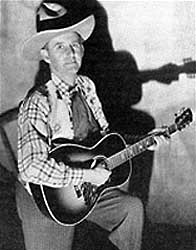 The other two inclusions give us, first, Git Along Little Pony (1944), a number written by Ray Whitley, performed by the western swing act, the Jimmy Wakely Trio (aka, the Plainsmen; aka, the Roughriders; aka, the Prairie Ramblers). They consisted of Jimmy Wakely, Johnny Bond, & Scotty Harrel, all of 'em b-western filmstars. The other two inclusions give us, first, Git Along Little Pony (1944), a number written by Ray Whitley, performed by the western swing act, the Jimmy Wakely Trio (aka, the Plainsmen; aka, the Roughriders; aka, the Prairie Ramblers). They consisted of Jimmy Wakely, Johnny Bond, & Scotty Harrel, all of 'em b-western filmstars.
Plus there are the parallel harmony trio the Sunshine Girls. Among them you'll spot Mary Ford, who was singing western swing before she became a vocal act backed by her husband Les Paul. The cast is collectively credited as " Jimmy Wakely & His Oklahoma Cowboys & Cowgirls" though they're called that nowhere else.
Also included in the Songs of the Range anthology is Carson Robison & His Buckeroos (aka, & His Pioneers) sing the chestnut When It's Springtime in the Rockies (1941) working in a bit of the even roastier chestnut "Home Home on the Range." Carson & His Buckeroos (Billy & John Mitchell) are a good harmonizing band who manage a good deal of quality hillbilly authenticity.
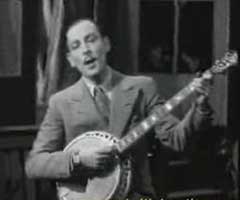 There's an older film version of When It's Springtime in the Rockies (1930) filmed by Pathetone in England when American singer Lou Abelardo "of Radio, Cabaret & Gramaphone fame" was in London. Pathetone was England's answer to America's Vitaphone. The films were frequently no longer than the later soundies. There's an older film version of When It's Springtime in the Rockies (1930) filmed by Pathetone in England when American singer Lou Abelardo "of Radio, Cabaret & Gramaphone fame" was in London. Pathetone was England's answer to America's Vitaphone. The films were frequently no longer than the later soundies.
Abelardo is a type of entertainer very common in the 1920s, standing completely outside the ragtime craze & all the jazz that followed, hoky singers with banjo or ukelele singing stuff like "Tiptoe through the Tulips."
With a pencil mustache & his hair plastered so flat it looks painted on a bald head, Abalardo sits almost as motionless as a department store dummy with just his fingers & lips moving, accompanying his song quite simply on banjo. He has a charming presence, like your faggot uncle entertaining the kiddies at Christmas.
Another short-short Pathetone of Lou Abelardo was released the prior year but filmed on the same set at the same time. It's S'pposing (1929). Lou would soonafter become associated with Ambrose & His Orchestra.
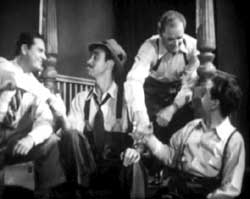 Frank Cook & the Four Merry Men appear in the Joe Bonica mini-musical Hi, Neighbor! (about 1953). Bonica ran a "film of the month club" in the '50s & shipped musicals, mini-documentaries, & nudie-cuties direct to peoples' homes to show on 16 mm or 8 mm projectors. Frank Cook & the Four Merry Men appear in the Joe Bonica mini-musical Hi, Neighbor! (about 1953). Bonica ran a "film of the month club" in the '50s & shipped musicals, mini-documentaries, & nudie-cuties direct to peoples' homes to show on 16 mm or 8 mm projectors.
A fellow dressed like a man who just got off work has loosened his tie, relaxing on a stoop of an apartment house watching kids fighting in a garbage-lined alley. In his deep, deep baritone he sings to the kids:
"Listen you sisters & brothers/ I've got some very good advice/ Hear me you sons of your mothers/ We're really going to break the ice..."
He then leaps from this introduction into the jauntier tune: "Hi, Neighbor! Hi, neighbor!/ What do you know & what do you say?/ Hi neighbor! Hi, neighbor! Throw all your troubles away..."
The other three members of the Four Merry Men enter the frame one by one & gather around Cook singing the friendly song.
A series of neighborly exchanges are shown, two gals trading gifts from their separate apartment windows; the two lads who'd been fighting sweeping the garbage from the street; a vendor rewarding the industrious boys with ice cream cones; & more neighborly scenes one after another.
It's all rather endearing & at the instrumental there's a guy sitting in one of the windows with one of the girls. He's playing rhythm guitar & playing a teency harmonica which if he weren't careful he could easily swallow.
This is Frank Cook, a great harmonica player. The Four Merry Men are better than upbeat family-oriented harmony groups tend to be, in fact they're great, but adding Cook's harmonica antics makes it great & wonderful wee film.
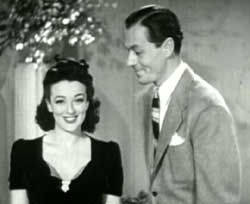 Bob Chester & His Orchestra were noted for Irish ballads & for imitating the Glenn Miller Orchestra. However, for the soundies he recorded two novelty tunes for dancing that give no sense of what his band was like, not that it was one of the great ones in any case.
Bob Chester & His Orchestra were noted for Irish ballads & for imitating the Glenn Miller Orchestra. However, for the soundies he recorded two novelty tunes for dancing that give no sense of what his band was like, not that it was one of the great ones in any case.
Bi-I-Bi (1941) opens on a room crowded with hopping dancers, looking a little too American Bandstandish to be cool. The orchestra is visible over the heads of the teenagers.
As Bob conducts his Philadelphia-based band, the camera pulls in a little clower, & he turns around to sing the novelty tune:
"If ever you are at a party & you're not having fun/ I know a game that you can play that will liven everyone/ You just take any letter from the alphabet/ For instance, Betty, you take 'B,' & see what you can get."
For that last line Bob sauntered stage right to where Betty Bradley begins singing the childish lyrics: "B I Bi, B I Biddy-bi B O Biddy-bi B O Bo Biddy-bi Bo Bu..."
Bob then heads stage left to sing: "Now Kenny it's your turn, come on, it's up to you/ Take the letter K & see what you can do."
Kenny sings: "K I Ki, K O Ko," et cetera. And it's as foolish as can be imagined, without quite really being funny, but only dumb.
I guess it's possible youngsters of the era sang this song the way I used to sing "The Name Game," a children's sing-along that became an R & B hit in the mid 'sixties. On the school bus we'd be taking turns with the names of all our friends: "Annie Annie Bo-banny, Banana-fanna fo-fanny, Fee fy mo-manny, Annie."
B-I-Bi is just lame is a similar kind of playful tune, though what charm it has isn't well preserved by Bob Chester & his crew. he introduces the third singer: "Now at this game my grampa is the very best/ For he's a cowboy from the wild & wooly west."
Bob Haymes (who was a songwriter) isn't dressed as a cowboy at all, but with long chin beard looks like a Quaker hobo in Daniel Boone get-up. He shouts "Yippy!" then does the verse with "W."
Haymes then introduces "Jane" who sings it with the letter "J," concluding her part with a jitterbug as the orchestra plays it like a serious instrumental.
Five solo vocalists (counting Chester) is a lot for one three-minute soundie, & piling them on didn't improve the song. I made a stab at figuring out who "Jane" & "Kenny" were, but failed. The guy looks a bit like Kenny Sargent from the Glen Grey orchestra, but seems awfully young.
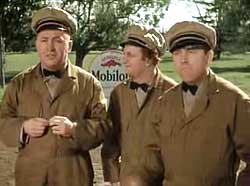 B-I-Bi really didn't make a very good soundie. But we have to count ourselves lucky because the song could've been done A to Z & lasted an hour.
B-I-Bi really didn't make a very good soundie. But we have to count ourselves lucky because the song could've been done A to Z & lasted an hour.
It's actual title is "The Alphabet Song" & was introduced by the Three Stooges in Violent is the Word for Curly (1938), & Stooge fans may take a certain delight in seeing such a stupid piece performed by a real band. And Stooge fans may take all the more delight in the fact that the Stooges performed it better than Bob Chester's crew of singers & musicians.
I've never been a Stooges fan & even as a small kid watching their old films on television, I was puzzled as to why the Marx Brothers were funny but the Three Stooges weren't. But Violent is the Word for Curly is quite good for a Stooges film, & at around a quarter-hour, no longer than can be tolerated.
A colorized version is in circulation. The colorizing process is so odd that everyone looks like corpses who've been made up by insane morticians.
Curly, Larry & Moe work in a full-service gas station. It's their first day on the job & it's doubtful they could do anything right even with instruction, but left to their own devices to figure it out, they just make a mess of it.
They try to provide super-service for three German professors in tophats eating fast-food in the back seat of a cool old luxury car. It's certainly no laugh riot, but the gags, such as they are, come fast & furious.
Once they've blown up the fancy car they steal an ice cream truck & escape. Curly was in the back of the truck & froze stiff, so the Moe & Larry rig him up on a campfire rotisary to thaw him out, which is funnier than the gas station gags as Curly thaws out while being turned on a spit & starts screaming.
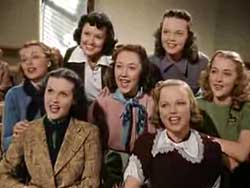 We'll next see them hitch-hiking in scholars' outfits which they accidentally stole from the three professors. Since clothes make the man, the Stooges are picked up by a wealthy matron who is a donor to the girls' college & she takes them to their new teaching jobs. We'll next see them hitch-hiking in scholars' outfits which they accidentally stole from the three professors. Since clothes make the man, the Stooges are picked up by a wealthy matron who is a donor to the girls' college & she takes them to their new teaching jobs.
They're supposed to be about the smartest professors Europe could send over. Of course the Stooges' attempts to pass themselves off as even moderately intelligent is pretty tough. Moe decides to test girl students' mental acuity by teaching them "The Alphabet Song."
Moe then all the Stooges start it off, & the college girls join it most sweetly. It's a lot better done here than when it was done as a soundie!
The song is just cute as flea dung & Curly is especially fun singing it. The girls harmonize beautifully & the Stooges even provide some instrumentation. As the centerpiece of such a short movie, it ends up making this one very satisfying; even normal sensible people who find the Stooges repugnant should be able to enjoy this one.
There's still about five minutes to go in the film after the highlight of that song. None of what remains will be funny to anyone who doesn't find slapping & injuring inherently funny.
The real professors show up belatedly & seek revenge with an explosive formula trumped up in the science lab. Soon the Stooges are playing tackle football with a basketball, not knowing the ball is backed with explosive.
copyright © by Paghat the Ratgirl
|
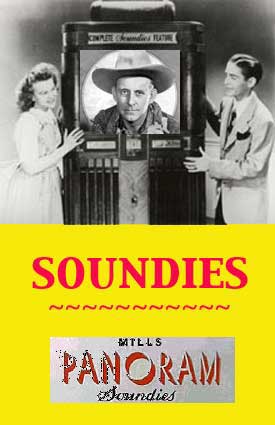

 She stands from the piano & the magic orchestra hidden somewhere in their home begins to play. It comes off as an awful song perhaps only because they're awful singer, Toni a mite worse than Jan.
She stands from the piano & the magic orchestra hidden somewhere in their home begins to play. It comes off as an awful song perhaps only because they're awful singer, Toni a mite worse than Jan.

 The other two inclusions give us, first, Git Along Little Pony (1944), a number written by Ray Whitley, performed by the western swing act, the Jimmy Wakely Trio (aka, the Plainsmen; aka, the Roughriders; aka, the Prairie Ramblers). They consisted of Jimmy Wakely, Johnny Bond, & Scotty Harrel, all of 'em b-western filmstars.
The other two inclusions give us, first, Git Along Little Pony (1944), a number written by Ray Whitley, performed by the western swing act, the Jimmy Wakely Trio (aka, the Plainsmen; aka, the Roughriders; aka, the Prairie Ramblers). They consisted of Jimmy Wakely, Johnny Bond, & Scotty Harrel, all of 'em b-western filmstars. There's an older film version of When It's Springtime in the Rockies (1930) filmed by Pathetone in England when American singer Lou Abelardo "of Radio, Cabaret & Gramaphone fame" was in London. Pathetone was England's answer to America's Vitaphone. The films were frequently no longer than the later soundies.
There's an older film version of When It's Springtime in the Rockies (1930) filmed by Pathetone in England when American singer Lou Abelardo "of Radio, Cabaret & Gramaphone fame" was in London. Pathetone was England's answer to America's Vitaphone. The films were frequently no longer than the later soundies.


 We'll next see them hitch-hiking in scholars' outfits which they accidentally stole from the three professors. Since clothes make the man, the Stooges are picked up by a wealthy matron who is a donor to the girls' college & she takes them to their new teaching jobs.
We'll next see them hitch-hiking in scholars' outfits which they accidentally stole from the three professors. Since clothes make the man, the Stooges are picked up by a wealthy matron who is a donor to the girls' college & she takes them to their new teaching jobs.